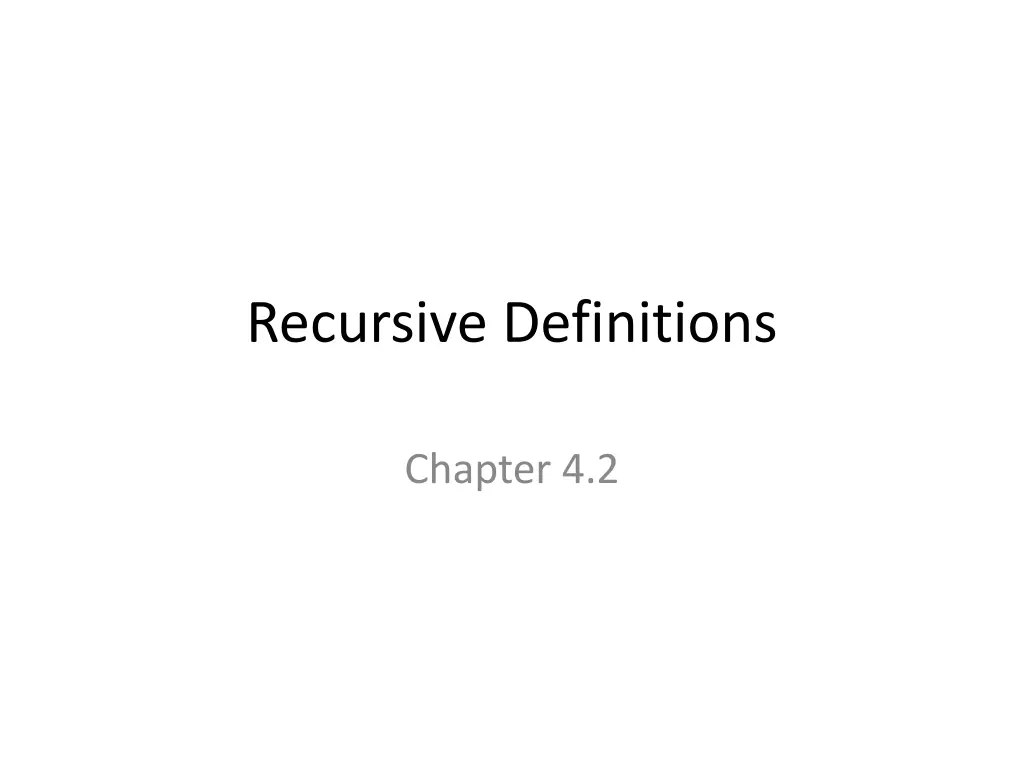
Understanding Recursive Definitions in Mathematics
Explore the concept of recursion and its application in mathematical induction through recursively defined sequences and functions. Learn how to define functions like factorial and Fibonacci numbers recursively, with examples to illustrate the principles involved.
Download Presentation

Please find below an Image/Link to download the presentation.
The content on the website is provided AS IS for your information and personal use only. It may not be sold, licensed, or shared on other websites without obtaining consent from the author. If you encounter any issues during the download, it is possible that the publisher has removed the file from their server.
You are allowed to download the files provided on this website for personal or commercial use, subject to the condition that they are used lawfully. All files are the property of their respective owners.
The content on the website is provided AS IS for your information and personal use only. It may not be sold, licensed, or shared on other websites without obtaining consent from the author.
E N D
Presentation Transcript
Recursive Definitions Chapter 4.2
Recursive Definitions Recursion is a principle closely related to mathematical induction. In a recursive definition, an object is defined in terms of itself. We can recursively define sequences, functions and sets.
Recursively Defined Sequences Example: The sequence {an} of powers of 2 is given by an= 2nfor n = 0, 1, 2, . The same sequence can also be defined recursively: a0= 1 an+1= 2an for n = 0, 1, 2, Obviously, induction and recursion are similar principles.
Recursively Defined Functions We can use the following method to define a function with the natural numbers as its domain: 1. Specify the value of the function at zero. 2. Give a rule for finding its value at any integer from its values at smaller integers. Such a definition is called recursive or inductive definition.
Recursively Defined Functions Example: f(0) = 3 f(n + 1) = 2f(n) + 3 f(0) = 3 f(1) = 2f(0) + 3 = 2 3 + 3 = 9 f(2) = 2f(1) + 3 = 2 9 + 3 = 21 f(3) = 2f(2) + 3 = 2 21 + 3 = 45 f(4) = 2f(3) + 3 = 2 45 + 3 = 93
Recursively Defined Functions How can we recursively define the factorial function f(n) = n! ? f(0) = 1 f(n + 1) = (n + 1)f(n) f(0) = 1 f(1) = 1f(0) = 1 1 = 1 f(2) = 2f(1) = 2 1 = 2 f(3) = 3f(2) = 3 2 = 6 f(4) = 4f(3) = 4 6 = 24
Recursively Defined Functions A famous example: The Fibonacci numbers f(0) = 0, f(1) = 1 f(n) = f(n 1) + f(n - 2) f(0) = 0 f(1) = 1 f(2) = f(1) + f(0) = 1 + 0 = 1 f(3) = f(2) + f(1) = 1 + 1 = 2 f(4) = f(3) + f(2) = 2 + 1 = 3 f(5) = f(4) + f(3) = 3 + 2 = 5 f(6) = f(5) + f(4) = 5 + 3 = 8
Recursively Defined Sets If we want to recursively define a set, we need to provide two things: an initial set of elements, rules for the construction of additional elements from elements in the set. Example: Let S be recursively defined by: 3 S (x + y) S if (x S) and (y S) S is the set of positive integers divisible by 3.
Recursively Defined Sets Proof: Let A be the set of all positive integers divisible by 3. To show that A = S, we must show that A S and S A. Part I: To prove that A S, we must show that every positive integer divisible by 3 is in S. We will use mathematical induction to show this.
Recursively Defined Sets Let P(n) be the statement 3n belongs to S . Basis step: P(1) is true, because 3 is in S. Inductive step: To show: If P(n) is true, then P(n + 1) is true. Assume 3n is in S. Since 3n is in S and 3 is in S, it follows from the recursive definition of S that 3n + 3 = 3(n + 1) is also in S. Conclusion of Part I: A S.
Recursively Defined Sets Part II: To show: S A. Basis step: To show: All initial elements of S are in A. 3 is in A. True. Inductive step: To show: (x + y) is in A whenever x and y are in S. If x and y are both in A, it follows that 3 | x and 3 | y. It follows that 3 | (x + y). Conclusion of Part II: S A. Overall conclusion: A = S.
Recursively Defined Sets Another example: The well-formed formulae of variables, numerals and operators from {+, -, *, /, ^} are defined by: x is a well-formed formula if x is a numeral or variable. (f + g), (f g), (f * g), (f / g), (f ^ g) are well-formed formulae if f and g are. 15
Recursively Defined Sets With this definition, we can construct formulae such as: (x y) ((z / 3) y) ((z / 3) (6 + 5)) ((z / (2 * 4)) (6 + 5))
Practice Problems (4.2) 1, 6, 11, 16, 17
